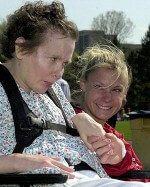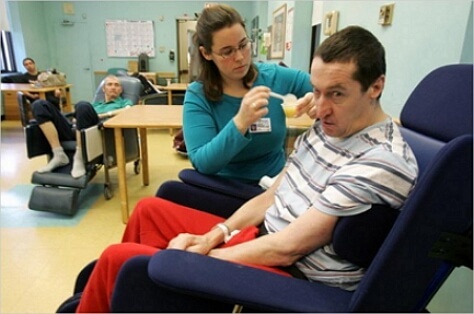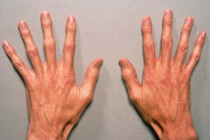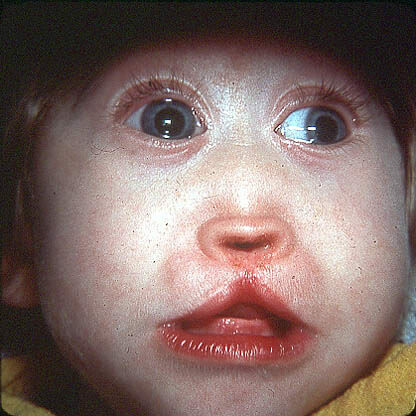Huntington's disease
 Huntington's disease is a severe progressive neurodegenerative hereditary disease of the brain, characterized by a combination of psychiatric disorders and choreic hyperkinesia. The prevalence of this disease is: 1: 10,000 population. Huntington's disease can develop both in childhood and in senile, but most often the first symptom is manifested in the age range of twenty-eight to fifty years.
Huntington's disease is a severe progressive neurodegenerative hereditary disease of the brain, characterized by a combination of psychiatric disorders and choreic hyperkinesia. The prevalence of this disease is: 1: 10,000 population. Huntington's disease can develop both in childhood and in senile, but most often the first symptom is manifested in the age range of twenty-eight to fifty years.
Huntington's disease - causes of
development. Because this disease is progressing steadily and leads to inevitable disability, Affecting the interests of both the patient and his relatives( in children of a sick person the risk of developing the disease is close to 50%), in recent years, Huntington's disease has been studied especially closely. The results were seriously alarmed by specialists, as it turned out that the disease is much more widespread than previously thought. Almost 100% of the cases examined gave a positive result for a family history. Some scientists suggest that occasionally a new case of the development of the disease may appear due to a genetic mutation, but there is as yet no similar proven case. Sometimes a false impression of the absence of a family history may result from a late debut of the disease and can be mistakenly classified as senile dementia, especially when family members die before the manifestation of the disease from other causes.
Huntington's disease - symptoms and signs
The disease always beginsGradually, as it were, gradually. The first symptoms of Huntington's disease usually appear in the age range of twenty-five to fifty( very rarely in childhood), men are sick more often than women. The first symptoms of the disease include fussiness and restlessness, which is usually not regarded by relatives as a disease. Over time, motor disorders continue to progress, which ultimately leads to disability. As the progression of Huntington's disease progresses, sudden frequent irregular spasmodic movements of the trunk and extremities become typical for the patient, a violation of articulation may occur, involuntary sobs and spasms of the facial musculature are possible. Coordination of movements during walking significantly suffers, the gait becomes a trochaic( dancing).Up to the latest stages of the disease memory remains safe, but executive functions, thinking and attention are violated at the very beginning of the disease. Often, obsessive conditions and nonsense are observed in Huntington's disease( schizophrenia can be mistakenly diagnosed for this symptomatology), periodic disinhibition, alienation, apathy and depression. Gradually, all the functions requiring muscular control are violated: a person begins to experience problems with swallowing and chewing, begins to grimace( due to rapid eye movement, sleep is disturbed).
The duration of the disease on average is fifteen years. In the case of an early onset( before the age of twenty), the disease is accompanied by cognitive impairment, ataxia, stiffness and progresses faster( about eight years).Epileptic seizures in Huntington's disease occur extremely rarely in the case of late onset of the disease, and often enough in its early form.
In the fourth to fifth decades of life, Huntington's disease appears progressive choreoathetosis, which in turn is accompanied by pronounced mental disorders( depression with frequent suicidal attempts, dementias, frequent outbreaks of aggression and irritation).In adolescence, the disease can sometimes manifest as a growing akinetic-rigid syndrome.
Huntington's disease is extremely slow. Invalidization is caused both by serious changes in the psyche and by deepened motor disorders. Lethal outcome occurs after many years from suicide or intercurrent infection 
Huntington's disease - diagnosis
In typical cases, the diagnosis of the disease is not difficult. Slowly progressing course, relatively late onset, absence of concomitant rheumatic fever and marked dementia make it possible to exclude Sydenham's chorea. In addition, a differential diagnosis should be made with such diseases as hereditary benign chorea, senile chorea, ataxia, neuroacanthocytosis, Parkinson's disease. In all disputable diagnostic cases, the decisive factor will be the results of direct DNA testing.
key factors for proper diagnosis of the disease is based on the type of inheritance and the presence of family history of the disease, the presence in the blood smear of a modified form of red blood cells, the presence and localization of atrophic processes in the cerebral hemispheres of the brain
Huntington's Disease - Treatment
Unfortunately, to date, has not been developed orOne method of treatment that can stop, or at least suspend the progression of the disease. All attempts aimed at the possible suppression of pathological movements in most cases are ineffective. In some cases, psychotropic drugs of a group of neuroleptics are prescribed for patients to reduce motor disorders and correct emotional disorders. To reduce the severity of the symptoms of Huntington's disease was specially developed and subsequently in 2008 approved the drug Tetrabenazine. Such drugs as Remacemid and Amantadine are still under testing, however they have already shown positive results. To facilitate rigidity and hypokinesia of muscles, antiparkinsonian drugs are prescribed. To facilitate myoclonic hyperkinesia, valproic acid is used. In case of behavioral disorders and psychoses, atypical antipsychotics are prescribed. To eliminate depression, Mirtazapine and serotonin reuptake inhibitors are widely used.
The prognosis of Huntington's disease is in most cases unfavorable. Lethal outcome, due to various complications( congestive heart activity, pneumonia, etc.), usually occurs after a lapse of ten to twelve years from the beginning of the disease progression.



